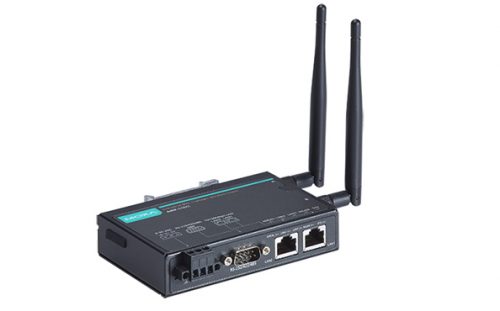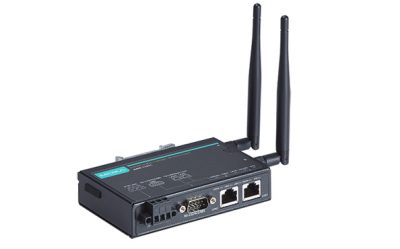- Description Specs Details Overview Components Packages Resources Additional Modules Complementary products Architecture Tools Benefits Features Customer Ordering
- Thông số Specs Details Overview Components Packages Resources Additional Modules Complementary products Architecture Tools Benefits Features Customer Ordering
- Ordering Specs Details Overview Components Packages Resources Additional Modules Complementary products Architecture Tools Benefits Features Customer Ordering
- Tài liệu Specs Details Overview Components Packages Resources Additional Modules Complementary products Architecture Tools Benefits Features Customer Ordering
Features and Benefits
- IEEE 802.11a/b/g/n compliant client
- Comprehensive interfaces with one serial port and two Ethernet LAN ports
- Client-based millisecond-level Turbo Roaming
- 2×2 MIMO future-proof technology
- Integrated robust antenna and power isolation
- Anti-vibration design
- Compact size for your industrial applications
- Easy setup, easy deployment with AeroMag
Introduction
The AWK-1137C is an ideal client solution for industrial wireless obile applications. It enables WLAN connections for both Ethernet and serial devices, and is compliant with industrial standards and approvals covering operating temperature, power input voltage, surge, ESD, and vibration. The AWK-1137C can operate on either the 2.4 or 5 GHz bands, and is backwards-compatible with existing 802.11a/b/g deployments to future-proof your wireless investments.
Industrial Ruggedness
• Integrated antenna and power isolation designed to provide 500 V insulation protection against external electrical interference
• -40 to 75°C wide operating temperature models (-T) available for smooth wireless communication in harsh environments
Mobility-Oriented Design
• Client-based Turbo Roaming for < 150 ms roaming recovery time between APs
• MIMO technology to ensure transmitting and receiving capability while on the move
• Anti-vibration performance (with reference to IEC 60068-2-6) Easy Integration
• Semi-automatically configurable to reduce deployment cost
• Use AeroMag for error-free setup of your industrial applications’ fundamental WLAN settings
• Various communication interfaces for connecting to different types of devices
• One-to-many NAT to simplify your machine setup
| • WLAN Interface | |
| Standards | IEEE 802.11a/b/g/n for Wireless LAN IEEE 802.11i for Wireless Security IEEE 802.3 for 10BaseT IEEE 802.3u for 100BaseT(X) |
| Spread Spectrum and Modulation (typical) | • DSSS with DBPSK, DQPSK, CCK • OFDM with BPSK, QPSK, 16QAM, 64QAM • 802.11b: CCK @ 11/5.5 Mbps, DQPSK @ 2 Mbps, DBPSK @ 1 Mbps • 802.11a/g: 64QAM @ 54/48 Mbps, 16QAM @ 36/24 Mbps, QPSK @ 18/12 Mbps, BPSK @ 9/6 Mbps • 802.11n: 64QAM @ 300 Mbps to BPSK @ 6.5 Mbps (multiple rates supported) |
| Operating Channels (central frequency) | US: 2.412 to 2.462 GHz (11 channels) 5.180 to 5.240 GHz (4 channels) 5.745 to 5.825 GHz (5 channels) 5.260 to 5.320 GHz (4 channels) 5.500 to 5.700 GHz (11 channels) EU: 2.412 to 2.472 GHz (13 channels) 5.180 to 5.240 GHz (4 channels) 5.260 to 5.320 GHz (4 channels) 5.500 to 5.700 GHz (11 channels) JP: 2.412 to 2.484 GHz (14 channels, DSSS) 5.180 to 5.240 GHz (4 channels) 5.260 to 5.320 GHz (4 channels) 5.500 to 5.700 GHz (11 channels) |
| Security | • SSID broadcast enable/disable • Firewall for MAC/IP/Protocol/Port-based filtering • 64-bit and 128-bit WEP encryption, WPA/WPA2-Personal and Enterprise (IEEE 802.1X/RADIUS, TKIP, and AES) |
| Transmission Rates | 802.11b: 1, 2, 5.5, 11 Mbps 802.11a/g: 6, 9, 12, 18, 24, 36, 48, 54 Mbps 802.11n: 6.5 to 300 Mbps (multiple rates supported) |
| TX Transmit Power | 802.11b: Typ. 26±1.5 dBm @ 1 Mbps, Typ. 26±1.5 dBm @ 2 Mbps Typ. 26±1.5 dBm @ 5.5 Mbps, Typ. 25±1.5 dBm @ 11 Mbps 802.11g: Typ. 23±1.5 dBm @ 6 to 24 Mbps, Typ. 22±1.5 dBm @ 36 Mbps Typ. 20±1.5 dBm @ 48 Mbps, Typ. 19±1.5 dBm @ 54 Mbps 802.11n (2.4 GHz): Typ. 23±1.5 dBm @ MCS0/8 20 MHz Typ. 17±1.5 dBm @ MCS7/15 20 MHz Typ. 23±1.5 dBm @ MCS0/8 40 MHz Typ. 17±1.5 dBm @ MCS7/15 40 MHz 802.11a: Typ. 23±1.5 dBm @ 6 to 24 Mbps Typ. 21±1.5 dBm @ 36 Mbps Typ. 20±1.5 dBm @ 48 Mbps, Typ. 18±1.5 dBm @ 54 Mbps 802.11n (5 GHz): Typ. 23±1.5 dBm @ MCS0/8 20 MHz Typ. 18±1.5 dBm @ MCS7/15 20 MHz Typ. 23±1.5 dBm @ MCS0/8 40 MHz, Typ. 18±1.5 dBm @ MCS7/15 40 MHz |
| Note | Based on regional regulations, the maximum transmission power allowed on the UNII bands is restricted in the firmware, as indicated below: |
| Table | |
| RX Receive Sensitivity | 802.11b: -89 dBm @ 1 Mbps, -89 dBm @ 2 Mbps -89 dBm @ 5.5 Mbps, -88 dBm @ 11 Mbps 802.11g: -88 dBm @ 6 Mbps, -88 dBm @ 9 Mbps -88 dBm @ 12 Mbps, -87 dBm @ 18 Mbps -84 dBm @ 24 Mbps, -81 dBm @ 36 Mbps -77 dBm @ 48 Mbps, -75 dBm @ 54 Mbps 802.11n (2.4 GHz): -70 dBm @ MCS7 20 MHz, -70 dBm @ MCS15 20 MHz -64 dBm @ MCS7 40 MHz, -65 dBm @ MCS15 40 MHz 802.11a: -90 dBm @ 6 Mbps, -88 dBm @ 9 Mbps -87 dBm @ 12 Mbps, -85 dBm @ 18 Mbps -81 dBm @ 24 Mbps, -78 dBm @ 36 Mbps -74 dBm @ 48 Mbps, -73 dBm @ 54 Mbps 802.11n (5 GHz): -69 dBm @ MCS7 20 MHz, -70 dBm @ MCS15 20 MHz -64 dBm @ MCS7 40 MHz, -66 dBm @ MCS15 40 MHz |
| • Protocol Support | |
| General Protocols | Proxy ARP, DNS, HTTP, HTTPS, IP, ICMP, SNTP, TCP, UDP, RADIUS, SNMP, DHCP, VLAN |
| • Interface | |
| Default Antennas | 2 dual-band omni-directional antennas, 2 dBi, RP-SMA (male) |
| Connector for External Antennas | RP-SMA (female) |
| LAN Ports | 2, RJ45, 10/100/1000BaseT(X) auto negotiation speed, F/H duplex mode, and auto MDI/MDI-X connection |
| Serial Port | 1, RS232/422/485, DB9 male connector |
| Reset | Present |
| LED Indicators | SYS, WLAN, LAN1, LAN2, Serial |
| • Serial Communication Parameters | |
| Data Bits | 5, 6, 7, 8 |
| Stop Bits | 1, 1.5, 2 |
| Parity | None, Even, Odd, Space, Mark |
| Flow Control | RTS/CTS, XON/XOFF |
| Baudrate | 75 bps to 921.6 kbps |
| Serial Data Log | 256 KB |
| • Serial Signals | |
| RS-232 | TxD, RxD, RTS, CTS, DCD, GND |
| RS-422 | Tx+, Tx-, Rx+, Rx-, GND |
| RS-485-4w | Tx+, Tx-, Rx+, Rx-, GND |
| RS-485-2w | Data+, Data-, GND |
| • Management | |
| Serial Operation Modes | Real COM, RCF2217, TCP Server, TCP Client, UDP |
| Device Management | Wireless Search Utility, MXconfig, SNMP |
| Network Monitoring | MXview |
| • Physical Characteristics | |
| Housing | Metal casing for high EMC-levels; provides IP30 protection |
| Weight | 470 g (1.03 lb) |
| Dimensions | 77.1 x 115.5 x 26 mm (3.035 x 4.55 x 1.024 in) |
| Installation | DIN-rail mounting (standard), wall mounting (with optional kit) |
| • Environmental Limits | |
| Operating Temperature | Standard Models: 0 to 60°C (32 to 140°F) Wide Temp. Models: -40 to 75°C (-40 to 167°F) |
| Storage Temperature | -40 to 85°C (-40 to 185°F) |
| Ambient Relative Humidity | 5% to 95% (non-condensing) |
| • Power Requirements | |
| Input Voltage | 9 to 30 VDC, redundant dual DC power inputs |
| Connector | 3-pin removable terminal block, 500 V insulation |
| Power Consumption | 11.7 W |
| Reverse Polarity Protection | Present |
| • Standards and Certifications | |
| Safety | UL 60950-1 |
| EMC | EN 55032/55024, EN 61000-6-2/6-4 |
| EMI | FCC Part 15B |
| EMS | IEC 61000-4-2 ESD: Contact: 8 kV; Air: 15 kV IEC 61000-4-3 RS: 80 MHz to 1 GHz: 10 V/m IEC 61000-4-4 EFT: Power: 2 kV; Signal: 1 kV IEC 61000-4-5 Surge: Power: 2 kV; Signal: 1 kV IEC 61000-4-6 CS: 10 V IEC 61000-4-8 |
| Radio | FCC ID SLE-1137C, MIC, RED, NCC, KC, RCM, ANATEL, EAC, WPC |
| Vehicle | E-Mark E1 |
| Note | Please check Moxa’s website for the most up-to-date certification status. |
| • MTBF (mean time between failures) | |
| Time | 1,125,942 hrs |
| Standard | Telcordia SR332 |
Available Models
| Model No. | Description | |
|---|---|---|
| AWK-1137C-US | Industrial 802.11a/b/g/n wireless serial/Ethernet client, US band, 0 to 60°C | |
| AWK-1137C-US-T | Industrial 802.11a/b/g/n sireless serial/Ethernet client, US band, -40 to 75°C | |
| AWK-1137C-EU | Industrial 802.11a/b/g/n wireless serial/Ethernet client, EU band, 0 to 60°C | |
| AWK-1137C-EU-T | Industrial 802.11a/b/g/n wireless serial/Ethernet Client, EU band, -40 to 75°C | |
| AWK-1137C-JP | Industrial 802.11a/b/g/n wireless serial/Ethernet client, JP band, 0 to 60°C | |
| AWK-1137C-JP-T | Industrial 802.11a/b/g/n wireless serial/Ethernet client, JP band, -40 to 75°C |
Optional Accessories
 Wireless LAN Antennas
Wireless LAN Antennas
| Model No. | Description | |
|---|---|---|
| MAT-WDB-CA-RM-2-0205 | MIMO 2×2, 2.4/5 GHz, dual-band ceiling antenna, 2/5 dBi, RP-SMA-type (male) |
White Paper: A Guide to an Error-Free Wi-Fi Network Lifecycle
In this article, we discuss some key points to consider when planning and deploying a Wi-Fi network in an industrial environment…more
Application Notes: AeroMag Technology for Fast and Easy Wi-Fi Network Deployment and Maintenance
Moxa’s Wi-Fi solution includes AeroMag, a unique technology that can save you significant time and effort on basic device settings when deploying and maintaining a network without compromising on network security….more



